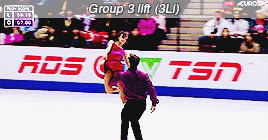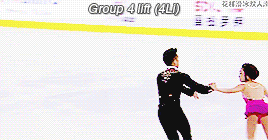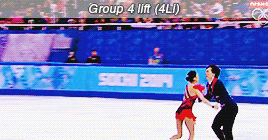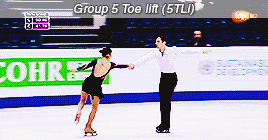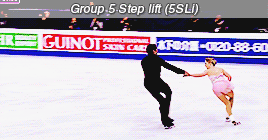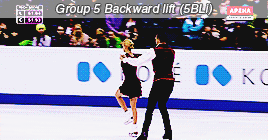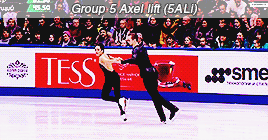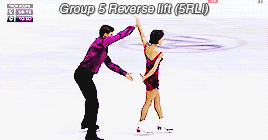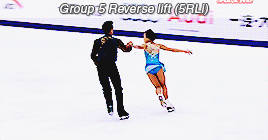
Introduction to Lifts in Pairs Skating
Introduction to Lifts in Pairs Skating
This guide will explain lift elements in pairs skating.
More intro to skating guides are available here. Please do not reproduce any part of this post without permission.
LAST UPDATED: Jan 29, 2022
Lifts are vital elements in both pairs skating and ice dance. In pairs lifts, the male partner must hold the female partner over his head while rotating and traveling across the ice. Lifts have two main qualities: the hold or point of contact between partners - hand-to-armpit, hand-to-waist, hand-to-hip, or hand-to-hand - and the woman’s position during the lift - upright (upper body vertical), star (body sideways), or platter (facing up or down, upper body parallel to the ice).
There are five “groups” of lifts based on the hold of the partners during takeoff. Base value increases as the group number increases. One lift is required in the pairs short program (the type changes each season) and three in the free program for senior skaters (two for juniors). Lifts are a leveled element, with increasing base value from level B through levels 1-4. Level features for pairs lifts include difficult entries and exits, changes of hold or position, change of rotational direction, additional revolutions, and so on. Changes in hold/position are common in pairs lifts - even necessary to gain levels - but lifts are identified on protocols by the hold of the partners when the woman first passes the man’s shoulder. On protocols, lifts are abbreviated as “Li” with the group number before and the level after.
GROUP 1 LIFTS (1Li)
Hand-to-armpit hold. The male partner holds the female partner by her armpit and hand. His arms are not fully extended. Group 1 lifts are never seen in elite skating.
(Skaters shown: Claire Fleming/Jack Liu)
GROUP 2 LIFTS (2Li)
Hand-to-waist hold. The male partner lifts with both hands on the female partner’s waist. His arms are fully extended. Group 2 lifts are rarely seen in elite skating.
(Skaters shown: Miu Suzaki/Ryuichi Kihara)
GROUP 3 LIFTS (3Li)
Hand-to-hip/upper leg. Same base value as Group 4 lifts. The male partner lifts with one hand on the female partner’s hip or upper leg. The teams in the examples all perform difficult entries, which count as a level feature.
Sui/Han’s lift exhibits a change of hold and position. Wenjing begins in a star position and changes to a platter position.
Iliushechkina/Moscovitch perform a dance lift into a pairs lift. Their lift exhibits a change in rotational direction, which can count as a level feature for one lift per program. Lubov remains in a star position throughout the lift.
Ksenia performs a somersault into the lift and maintains a single position throughout.
(Skaters shown: Wenjing Sui/Cong Han, Lubov Iliushechkina/Dylan Moscovitch, Ksenia Stolbova/Fedor Klimov)
GROUP 4 LIFTS (4Li)
Hand-to-hand press lift. Same base value as Group 3 lifts. Partners face each other before takeoff. Both hands are in contact as the male partner lifts the female partner directly upwards. In the examples shown, each team changes hold and position mid-lift.
Pang/Tong perform a carry with Tong in a spreadeagle position and Pang in a star position. All lifts must rotate, but executing a carry for at least 3 seconds while the man performs a spreadeagle, crossovers, or similar moves can also count as a level feature in the free skate, but only the first time it is executed. Carries are allowed in the short program, but do not count as a level feature.
(Skaters shown: Wenjing Sui/Cong Han, Aliona Savchenko/Bruno Massot, Qing Pang/Jian Tong)
GROUP 5 LIFTS
Group 5 lifts have the highest base values of all pairs lifts. In both Group 4 and Group 5 lifts, partners are in a hand-to-hand hold at the beginning of the lift. The key difference for Group 5 lifts is the woman rotating or “swinging” around the man during the lifting process, hence the other name for Group 5 lifts, “lasso lifts”. There are five types of Group 5 lifts, categorized by the takeoff of the woman, the position of the partners relative to each other during takeoff, and the hand hold. In order of increasing base value:
—-
GROUP 5 TOE LIFT (5TLi)
Same base value as step lifts. At the moment of takeoff, partners are face to face with the man skating forward and woman backward, right hand in right and left hand in left. The woman takes off from her toe.
(Skaters shown: Tatiana Danilova/Mikalai Kamianchuk)
—-
GROUP 5 STEP LIFT (5SLi)
Same base value as toe lifts. At the moment of takeoff, partners are face to face with the man skating backward and woman forward, right hand in right and left hand in left. The woman “steps” into the lift from a forward edge.
(Skaters shown: Julianne Seguin/Charlie Bilodeau)
—-
GROUP 5 BACKWARD LIFT (5BLi)
At the moment of takeoff, both partners skate backwards, right hand in right and left hand in left. The woman takes off using the blade or toe pick.
(Skaters shown: Tatiana Volosozhar/Maxim Trankov)
—-
GROUP 5 AXEL LIFT (5ALi)
Same base value as reverse lifts. At the moment of takeoff, the woman is at the man’s side, right hand in right and left hand in left. The man skates forward or in a spreadeagle position. The woman takes off from a forward edge, like an axel jump. In the examples above, Cong and Ksenia enter their lifts in a spreadeagle position.
(Skaters shown: Wenjing Sui/Cong Han, Ksenia Stolbova/Fedor Klimov)
—-
GROUP 5 REVERSE LIFT (5RLi)
Same base value as axel lifts. At the moment of takeoff, both partners skate in the same direction, either backward or forward with the hand hold being right to left and left to right, the opposite of other Group 5 lifts. The woman takes off using the blade or toe pick.
Lubov reaches across her back with her right hand to take Dylan's left hand.
Cong reaches under Wenjing's leg to take her right hand with his left hand. Notice how in the fully extended lift position (before any position changes), they face in opposite directions, a characteristic of reverse lifts.
(Skaters shown: Lubov Iliushechkina/Dylan Moscovitch, Wenjing Sui/Cong Han)



